
12 minute read
MAINTENANCE SAFETY
Instructions are necessary before operating or servicing machine. Read and understand the Operation & Maintenance Manual, Operator’s Handbook and signs (decals) on machine. Follow warnings and instructions in the manuals when making repairs, adjustments or servicing. Check for correct function after adjustments, repairs or service. Untrained operators and failure to follow instructions can cause injury or death.
W-2003-0903
Safety Alert Symbol: This symbol with a warning statement, means: “Warning, be alert! Your safety is involved!” Carefully read the message that follows.
CORRECT
CORRECT
CORRECT
Never service the Bobcat Compact Excavator without instructions.
Use the correct procedure to lift and support the excavator.
Cleaning and maintenance are required daily.
Have good ventilation when welding or grinding painted parts. Wear dust mask when grinding painted parts. Toxic dust and gas can be produced.
WRONG
Stop, cool and clean engine of flammable materials before checking fluids.
Never service or adjust machine with the engine running unless instructed to do so in the manual. Avoid contact with leaking hydraulic fluid or diesel fuel under pressure. It can penetrate the skin or eyes.
Never fill fuel tank with engine running, while smoking, or when near open flame.

Vent exhaust to outside when engine must be run for service. Exhaust system must be tightly sealed. Exhaust fumes can kill without warning.
Always lower the bucket and blade to the ground before doing any maintenance.
Never modify equipment or add attachments not approved by Bobcat Company.
Keep body, jewelry and clothing away from moving parts, electrical contact, hot parts and exhaust. Wear eye protection to guard from battery acid, compressed springs, fluids under pressure and flying debris when engines are running or tools are used. Use eye protections approved for type of welding. Keep tailgate closed except for service. Close and latch tailgate before operating the excavator.
Lead-acid batteries produce flammable and explosive gases. Keep arcs, sparks, flames and lighted tobacco away from batteries.
Batteries contain acid which burns eyes or skin on contact. Wear protective clothing. If acid contacts body, flush well with water. For eye contact flush well and get immediate medical attention.
Maintenance procedures which are given in the Operation & Maintenance Manual can be performed by the owner/ operator without any specific technical training. Maintenance procedures which are not in the Operation & Maintenance Manual must be performed ONLY BY QUALIFIED BOBCAT SERVICE PERSONNEL. Always use genuine Bobcat replacement parts. The Service Safety Training Course is available from your Bobcat dealer.
MSW28-0805

Service Schedule
Chart
Maintenance work must be done at regular intervals. Failure to do so will result in excessive wear and early failures. The service schedule is a guide for correct maintenance of the Bobcat Excavator.
Warning
Engine Coolant
Engine Oil
Hydraulic Fluid, Hoses and Tubelines
Instructions are necessary before operating or servicing machine. Read and understand the Operation & Maintenance Manual, Operator’s Handbook and signs (decals) on machine. Follow warnings and instructions in the manuals when making repairs, adjustments or servicing. Check for correct function after adjustments, repairs or service. Untrained operators and failure to follow instructions can cause injury or death.
W-2003-0903
Check coolant level. Add premixed coolant as needed.
Check the engine oil level and add as needed.
Check the hydraulic fluid level and add as needed. Check for damage and leaks. Repair or replace as needed.
Engine Air Filter and Air SystemCheck condition indicator and empty dust cup as needed. Check air system for leaks.
Tracks Check and adjust track tension as needed.
Indicators and Lights Check for correct operation of all indicators and lights.
Control Console LockoutCheck for proper function. Repair or replace as needed.
Operator Canopy/Cab Check condition. Check mounting hardware.
Seat Belt Check condition. Check mounting hardware.
Safety Signs and Safety TreadsCheck for damaged signs (decals) and safety treads. Replace any signs or safety treads that are damaged or worn.
Pivot Points Grease all machinery pivot points.
Cab Heater Air Filter (Option)Clean the filter as needed.
Swing Circle and Pinion Grease two fittings.
Fuel Tank & Filter
Drain water and sediment from fuel tank and fuel filter.
Battery Check battery, cables, connections and electrolyte level. Add distilled water as needed.
Alternator / Fan Belt Check condition of belt and adjust as needed.
Spark Arrestor Muffler Clean the spark chamber.
Fuel Filter
Travel Motor
Engine Oil and Filter
Replace fuel filter.
•
Check lubricant level in both travel motors. ••
Replace oil & filter. Use CD or better grade oil and Bobcat filter.
Radiator, & Oil Cooler Clean debris from the radiator fins.
•
Hydraulic Filter Replace the filter. ••
Alternator & Starter
Engine Valves
Check the alternator and starter connections. ••
Check and adjust the engine valve clearance.
Travel Motor Replace lubricant in both travel motors.
Engine Cooling System Drain and flush the cooling system. Replace premixed coolant.
Hydraulic System Replace the hydraulic fluid and filters. Clean the reservoir. ••
• Also at first 50 hours.
•• Also at first 100 Hours.
■ Or every 6 months.
Control Console Lockouts
Inspection And Maintenance
When either console is raised [Figure PM-1] & [Figure PM-2], the hydraulic control levers (joysticks) and traction system must not function.
Sit in the operator's seat, fasten the seat belt and start the engine.
Raise the left console. (Green light on the console will go off.)
Move the joystick control levers. There should be no movement of the boom, arm, slew or bucket.

Move the steering control levers. There should be no movement of the excavator tracks.
Lower the left console. Raise the right console and repeat the inspection procedure.
The joystick control levers and traction system must be deactivated when either console is raised.
Service the system if these controls do not deactivate when either control console is raised. (See your Bobcat dealer for service.)
Failure to properly inspect and maintain the seat belt can cause lack of operator restraint resulting in serious injury or death.
W-2466-0703
Check the seat belt daily for correct function.
Inspect the seat belt system thoroughly yearly or more often if the machine is exposed to severe environmental conditions or applications.
The seat belt system should be repaired or replaced if it shows cuts, fraying, extreme or unusual wear, significant discolorations due to ultraviolet (UV) rays from the sun, dusty/dirty conditions, abrasion to the seat belt webbing, or damage to the buckle, latch plate, retractor (if equipped), or hardware.

B-22283
The items below are referenced in [Figure PM-3].
1.Check the seat belt webbing. If the system is equipped with a retractor, pull the webbing completely out and inspect the full length of the webbing. look for cuts, wear, fraying, dirt and stiffness.
2.Check the buckle and latch for proper function. Make sure latch plate is not excessively worn, deformed or buckle is not damaged.
3.Check the retractor web storage device (if equipped) by extending the seat belt webbing to determine if it extends and retracts the webbing correctly.
4.Check webbing in areas exposed to ultraviolet (UV) rays from the sun or extreme dust or dirt. If the original color of the webbing in these areas is extremely faded and / or the webbing is packed with dirt, the webbing strength may have weakened.
See your Bobcat dealer for approved seat belt system replacement parts for your machine.
TAILGATE
Opening And Closing
Warning
Avoid Injury Or Death
Never service or adjust the machine when the engine is running unless instructed to do so in the manual.

W-2012-0497
Warning
Keep the rear door closed when operating the machine. Failure to do so could seriously injure a bystander.
Adjusting The Bumper
Figure PM-5
Release the latch (Item 1) [Figure PM-4] and pull the tailgate open.
Push firmly to close the tailgate.
Note: The tailgate can be locked using the start key.
The door bumper (Item 1) [Figure PM-5] can be adjusted for alignment with the tailgate.

Close the tailgate before operating the excavator.
Adjusting The Latch
Figure PM-6
The door latch (Item 1) [Figure PM-6] can be adjusted by loosening the two bolts, moving the latch, and tightening the two bolts.
Close the tailgate before operating the excavator.
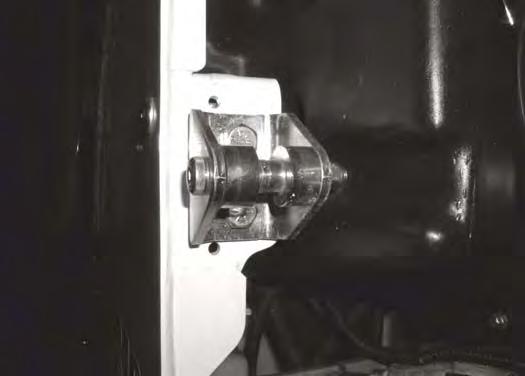
Cab Filters
Cleaning And Maintenance
The recirculation filter must be cleaned regularly. The filter is located at the right of the operator seat.
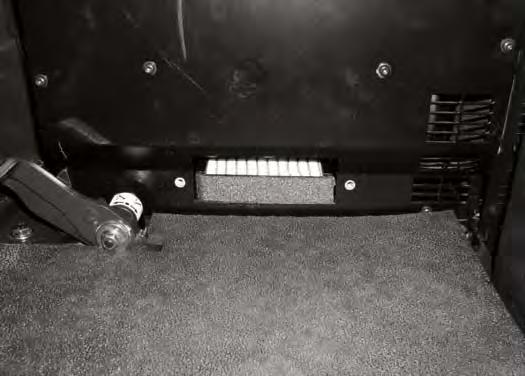
Remove the 2 bolts (Item 2) [Figure PM-7] and remove the
Remove the filter (Item 1) [Figure PM-8]. Shake the filter or use low air pressure to remove debris. Replace the filter after 3 cleanings or if the filter becomes to dirty to clean or damaged.
Reinstall the filter, cover and bolts.
The filter must be cleaned regularly.

Air Cleaner Service

See the SERVICE SCHEDULE for the correct service interval. (See SERVICE SCHEDULE on Page PM-5)
Daily Check
Figure PM-9
Replacing Filter Elements
Outer Filter
Pull the locking tab (Item 2) [Figure PM-9]
Turn the dust cup (Item 3) [Figure PM-9] counterclockwise about 1/8 turn.
Remove and clean the dust cup.
Check the condition indicator (Item 1) [Figure PM-9]. If the red ring shows in the condition indicator, the filter needs to be replaced.
Replace the inner filter every third time the outer filter is replaced or as indicated.
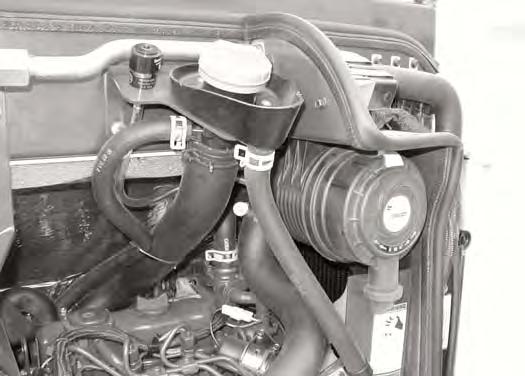
Pull the outer filter (Item 1) [Figure PM-10] from the air cleaner housing.
Check the housing for damage.
Clean the housing and the seal surface. DO NOT use compressed air.
Install a new outer filter.
AIR CLEANER (CONT’D)
Replacing Filter Elements (Cont’d)
Figure PM-11
Install the dust cup and turn about 1/8 turn clockwise [Figure PM-11]
Push locking tab in (Item 1) [Figure PM-11]
After the outer filter has been replaced, press the button (Item 2) [Figure PM-11] on the top of the condition indicator and start the engine. Run at full RPM, then reduce engine speed and stop the engine. If the red ring shows in the condition indicator, replace the inner filter.
Check the air intake hose and the air cleaner housing for damage. Make sure all connections are tight.

Inner Filter
Only replace the inner filter under the following conditions:
•Replace the inner filter every third time the outer filter is replaced.

•After the outer filter has been replaced, press the button (Item 2) [Figure PM-11] on the top of the condition indicator and start the engine. Run at full RPM, then reduce engine speed and stop the engine. If the red ring shows in the condition indicator, replace the inner filter.
Remove the dust cup, outer filter and inner filter.
NOTE: Make sure all sealing surfaces are free of dirt and debris.
Install the outer filter and the dust cup.
Press the button on the condition indicator to reset the condition indicator by remove the red ring.
Fuel System

Fuel Specifications
Use only clean, high quality diesel fuel, Grade No. 2 or Grade No. 1.
The following is a suggested blending guideline which should prevent fuel gelling problems during freezing temperature.
Filling The Fuel Tank
Open the tailgate.
Figure PM-13
Contact your fuel supplier for local recommendations.
Warning
Stop and cool the engine before adding fuel. NO SMOKING! Failure to obey warnings can cause an explosion or fire.
W-2063-0887
Warning
Always clean up spilled fuel or oil. Keep heat, flames, sparks or lighted tobacco away from fuel and oil. Failure to use care around combustibles can cause explosion or fire which can result in injury or death.
W-2103-1285
Remove the fuel fill cap (Item 1) [Figure PM-13].
Use a clean, approved safety container to add fuel. Add fuel only in an area that has a free movement of air and no flames or sparks. NO SMOKING!
Install and tighten the fuel fill cap. Close the tailgate.
See the SERVICE SCHEDULE for the service interval when to remove water from or replace the fuel filter.(See SERVICE SCHEDULE on Page PM-5)
FUEL SYSTEM (CONT’D)
Fuel Filters
Removing Water
Open the tailgate.
Loosen the drain (Item 1) [Figure PM-14] at the bottom of the filter to drain water from the filter.
Replacing Elements
Remove the filter (Item 2) [Figure PM-14]
Clean the area around the filter housing. Put clean oil on the seal of the new filter. Install the fuel filter and hand tighten.
Remove the air from the fuel system. (See Removing Air From The Fuel System on Page PM-14)

Draining The Fuel Tank
See the SERVICE SCHEDULE for the correct service interval. (See SERVICE SCHEDULE on Page PM-5)
Turn the upperstructure until the fuel tank drain is centered between the rear tracks.
Remove the access panel (Item 1) [Figure PM-15] on the bottom of the engine compartment. Loosen the clamp (Item 1) [Figure PM-16] and disconnect the fuel hose.
Drain the fuel into a container.

Reuse, recycle or dispose of fuel in an environmentally safe manner.

FUEL SYSTEM (CONT’D)
Removing Air From The Fuel System
After replacing the fuel filter or when the fuel tank has run out of fuel, air must be removed from the fuel system before starting the engine.
Open the fuel filter vent (Item 1) [Figure PM-17].
Operate the hand pump (priming bulb) (Item 2) [Figure PM-17] until the fuel flows from the vent with no air bubbles.
Close the vent (Item 1) [Figure PM-17] on the fuel filter housing.
Start the engine. It may be necessary to open the vent (Item 3) [Figure PM-17] (at the fuel injection pump) briefly until the engine runs smoothly.
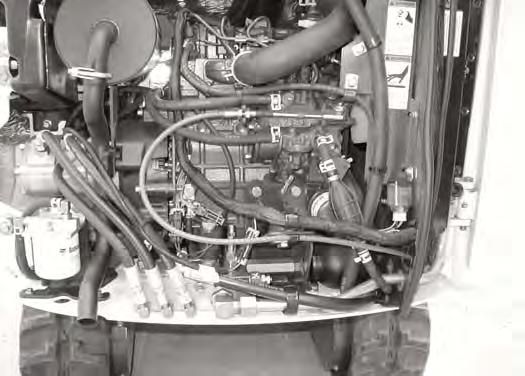
Warning
Diesel fuel or hydraulic fluid under pressure can penetrate skin or eyes, causing serious injury or death. Fluid leaks under pressure may not be visible. Use a piece of cardboard or wood to find leaks. Do not use your bare hand. Wear safety goggles. If fluid enters skin or eyes, get immediate medical attention from a physician familiar with this injury.
W-2072-0496
Engine Lubrication System

Checking And Adding Engine Oil
Check the engine oil every day before starting the engine for the work shift.
Figure PM-18
Open the tailgate and remove the dipstick (Item 1) [Figure PM-18]
Keep the oil level between the marks on the dipstick.
Engine Oil Chart
Figure PM-19
Use a good quality motor oil that meets the correct API Service Classification [Figure PM-19]
Install the dipstick and close the tailgate.
ENGINE LUBRICATION SYSTEM (CONT’D)
Removing And Replacing Oil And Filter
See the SERVICE SCHEDULE for the service interval for replacing the engine oil and filter. (See SERVICE SCHEDULE on Page PM-5)
Run the engine until it is at operating temperature. Stop the engine.


Open the tailgate.
Remove the engine oil drain plug (Item 1) [Figure PM20]. Drain the oil into a container and recycle or dispose of used oil in an environmentally safe manner.
Remove the oil filter (Item 2) [Figure PM-20] and clean the filter housing surface.
Use a genuine Bobcat filter.
Put clean oil on the filter gasket.
Install the filter and hand tighten.
Install and tighten the oil drain plug.
Remove the fill cap (Item 1) [Figure PM-21].
Put in 3.75 qt. (3,5 L) of oil into the engine.
Use a good quality motor oil that meets the correct API Service Classification [Figure PM-19]
Install the fill cap.
Start the engine and let it run for several minutes.
Stop the engine. Check for leaks at the oil filter. Check the oil level.
Add oil as needed if it is not at the top mark on the dipstick (Item 3) [Figure PM-20]
Engine Cooling System
Check the cooling system every day to prevent overheating, loss of performance or engine damage.
Cleaning
Open the tailgate.
Use air pressure or water pressure to clean the radiator and oil cooler.
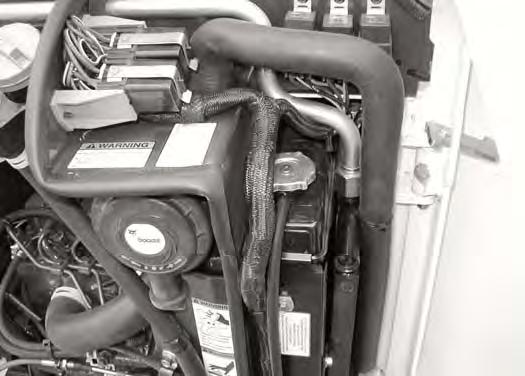
Checking Level
WARNING
AVOID BURNS
Do not remove radiator cap when the engine is hot. You can be seriously burned.
WARNING
Wear safety glasses to prevent eye injury when any of the following conditions exist:
•When fluids are under pressure.
•Flying debris or loose material is present.
•Engine is running.
•Tools are being used.
When the engine is cool, remove the radiator cap (Item 1) [Figure PM-22].
The coolant level must be 0.750 - 1.0 inch (20 - 25 mm) below the filler neck.
If the coolant level is low, add premixed coolant to the radiator.
Important
AVOID ENGINE DAMAGE
Always use the correct ratio of water to antifreeze.
Too much antifreeze reduces cooling system efficiency and may cause serious premature engine damage.
Too little antifreeze reduces the additives which protect the internal engine components; reduces the boiling point and freeze protection of the system.
Always add a premixed solution. Adding full strength concentrated coolant can cause serious premature engine damage.
ENGINE COOLING SYSTEM (CONT’D)



Removing And Replacing Coolant
See the SERVICE SCHEDULE for correct service intervals. (See SERVICE SCHEDULE on Page PM-5)
Turn the upperstructure so there is access to the engine and radiator from between the tracks. Stop the engine.
Warning
AVOID BURNS
Do not remove radiator cap when the engine is hot. You can be seriously burned.
When the engine is cool, loosen and remove the radiator cap
After all the coolant is removed, close the drain valves.
Recycle or dispose of the used coolant in an environmentally safe manner.
ENGINE COOLING SYSTEM (CONT’D)
Removing And Replacing Coolant (Cont’d)
Mix the coolant in a separate container.
NOTE: The cooling system is factory filled with propylene glycol (purple color). DO NOT mix propylene glycol with ethylene glycol.
Add premixed coolant; 47% water and 53% propylene glycol to the recovery tank if the coolant level is low.
One gallon and one pint of propylene glycol mixed with one gallon of water is the correct mixture of coolant to provide a -34°F (-37°C) freeze protection.
Important
Avoid Engine Damage
Always use the correct ratio of water to antifreeze.
Too much antifreeze reduces cooling system efficiency and may cause serious premature engine damage.
Too little antifreeze reduces the additives which protect the internal engine components; reduces the boiling point and freeze protection of the system.
Always add a premixed solution. Adding full strength concentrated coolant can cause serious premature engine damage.
I-2124-0497
Use a refractometer to check the condition of propylene glycol in your cooling system.
Add premixed coolant until the level is correct.
Run the engine until it is at operating temperature. Stop the engine. Check the coolant level and add as needed. Install the radiator cap and tighten.
Add coolant to the recovery tank as needed.
Close the tailgate.










